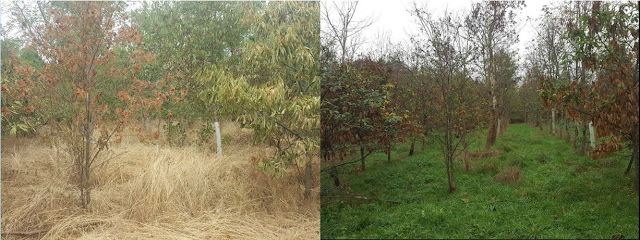Drought Recovery Autumn.
The peak of the heat was in mid-July 2022, the drought extended until the end of August. From September there was sufficient rain to keep trees growing. October and November have seen a continuous series of weather fronts crossing the country and now November the 19th the ditch is full within a couple of inches of the top at the lowest point in the triangular field. There has had not been a ground frost in Sutton until the 22nd Nov.). By mid-November the native Oaks had started losing their leaves and most Cherry, Red Oak and Robinia had dropped. The greenest leaves are on the Sweet Chestnuts. Particularly those that were had sprouted since the drought or high temperatures, though there are not that many of them. see Drought
 |
| Dead leaves in the crown of an E. gunnii on the left, epicormic shoots from the trunk on the right. |
 |
| A Taiwania which appeared to die in the drought showing epicormic regrowth. Unusual in a conifer. |
Most Eucalypts were not severely affected by the hot weather. One E. gunnii in the area of worst affected Sweet Chestnuts had a crown of dead leaves in August. By the middle of November epicormic shoots were appearing all the way up the trunk. The tree is fuel log size and should be felled if the crown has failed, which is suggested by the amount of epicormic growth. The tree may continue growing well but growth will be into thin lateral branches. If pollarded a few verticals may dominate. The Sweet Chestnut will be reviewed after the spring flush, those without leaders will be coppiced. I may take the opportunity to coppice some of the poorly shaped Sweet Chestnuts as well. They are in amongst pole stage trees and may struggle for light.






No comments:
Post a Comment